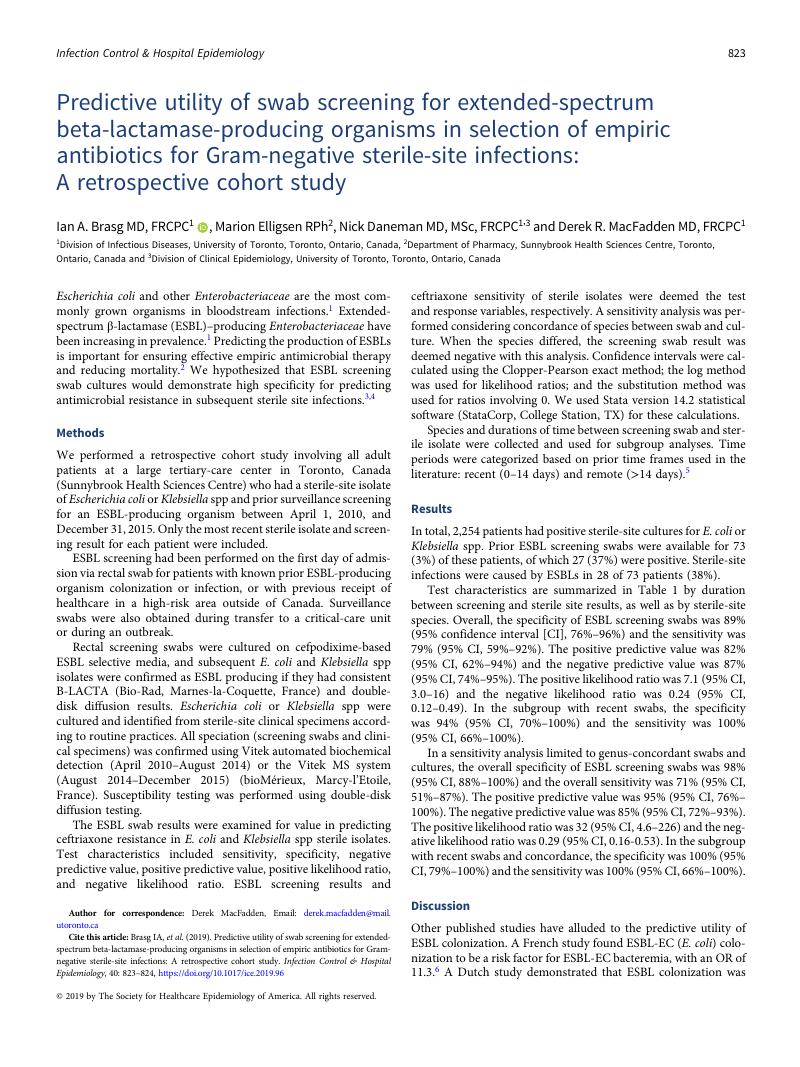No CrossRef data available.
Article contents
Predictive utility of swab screening for extended-spectrum beta-lactamase-producing organisms in selection of empiric antibiotics for Gram-negative sterile-site infections: A retrospective cohort study
Published online by Cambridge University Press: 29 April 2019
Abstract
An abstract is not available for this content so a preview has been provided. Please use the Get access link above for information on how to access this content.

- Type
- Research Brief
- Information
- Copyright
- © 2019 by The Society for Healthcare Epidemiology of America. All rights reserved
References
European Centre for Disease Prevention and Control. Antimicrobial resistance surveillance in Europe 2014. Annual Report of the European Antimicrobial Resistance Surveillance Network (EARS-Net). Stockholm: ECDC 2015.Google Scholar
Schwaber, MJ, Carmeli, Y. Mortality and delay in effective therapy associated with extended-spectrum β-lactamase production in Enterobacteriaceae bacteraemia: a systematic review and meta-analysis. J Antimicrob Chemother 2007;60:913–920.CrossRefGoogle ScholarPubMed
Brasg, I, Elligsen, M, MacFadden, D, Daneman, N. Predictive utility of swab screening for vancomycin-resistant Enterococcus in selection of empiric antibiotics for Enterococcus sterile-site infections: a retrospective cohort study. CMAJ Open 2017;5:E632–E637.CrossRefGoogle ScholarPubMed
MacFadden, DR, Elligsen, M, Robicsek, A, Ricciuto, DR, Daneman, N. Utility of prior screening for methicillin-resistant Staphylococcus aureus in predicting resistance of S. aureus infections. Canad Med Assoc J 2013;185:E725–E730.CrossRefGoogle ScholarPubMed
Goulenok, T, Ferroni, A, Bille, E, et al. Risk factors for developing ESBL E. coli: can clinicians predict infection in patients with prior colonization? J Hosp Infect 2013;84:294–299.CrossRefGoogle ScholarPubMed
Denis, B, Lafaurie, M, Donay, J-L, et al. Prevalence, risk factors, and impact on clinical outcome of extended-spectrum beta-lactamase-producing Escherichia coli bacteraemia: a five-year study. Int J Infect Dis 2015; 39:1–6.CrossRefGoogle ScholarPubMed
Frakking, FNJ, Rottier, WC, Dorigo-Zetsma, JW, et al. Appropriateness of empirical treatment and outcome in bacteremia caused by extended-spectrum β-lactamase–producing bacteria. Antimicrob Agent Chemother 2013;57:3092–3099.CrossRefGoogle ScholarPubMed
Van Aken, S, Lund, N, Ahl, J, Odenholt, I, Tham, J. Risk factors, outcome and impact of empirical antimicrobial treatment in extended-spectrum β-lactamase–producing Escherichia coli bacteraemia. Scand J Infect Dis 2014;46:753–762.CrossRefGoogle ScholarPubMed
Harris, PNA, Tambyah, PA, Lye, DC, et al. Effect of piperacillin-tazobactam vs meropenem on 30-day mortality for patients with E coli or Klebsiella pneumoniae bloodstream infection and ceftriaxone resistance: a randomized clinical trial. JAMA 2018;320:984–994.CrossRefGoogle ScholarPubMed


